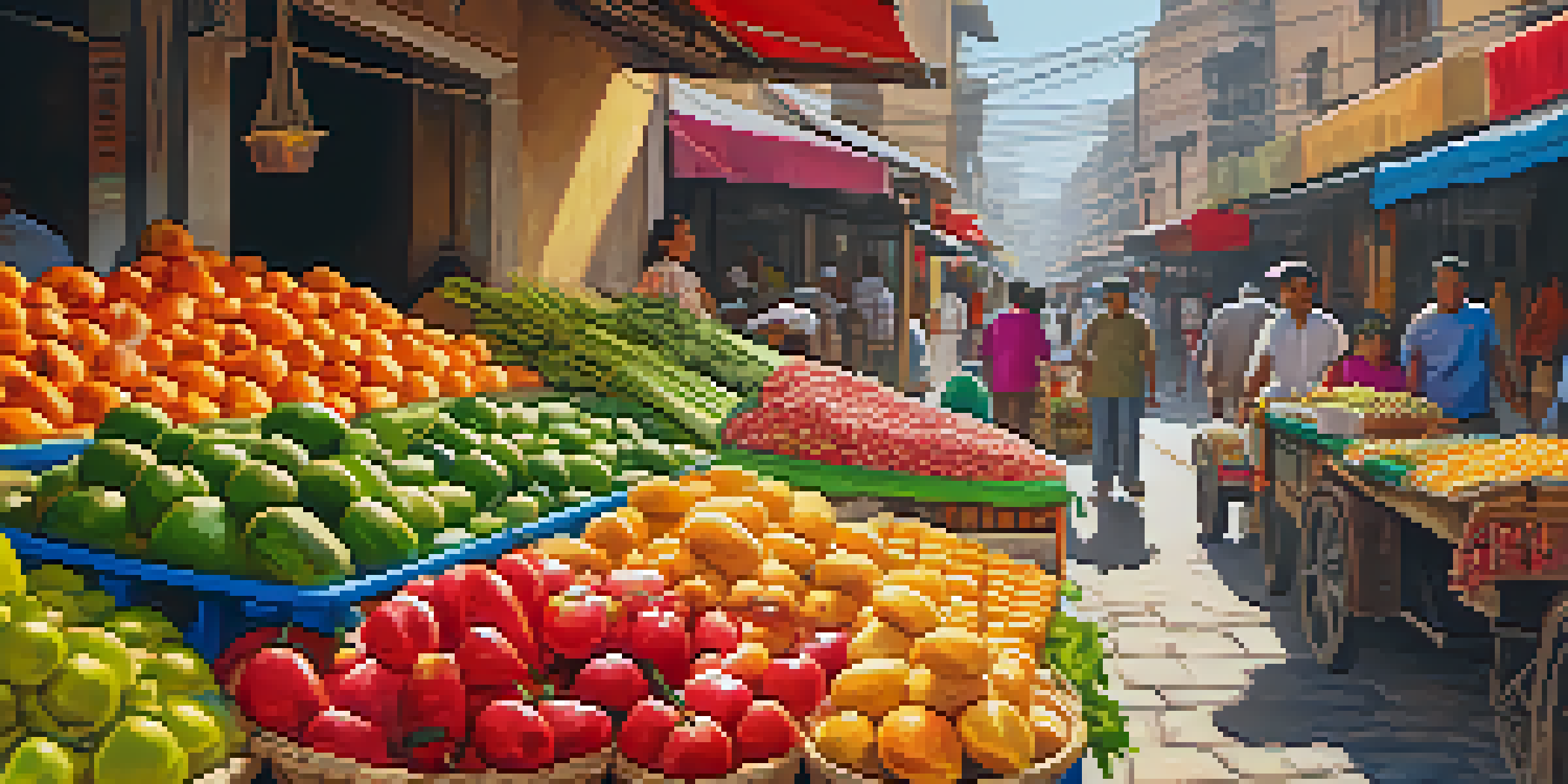Exploring Peru's Regional Cuisines: A Culinary Adventure Awaits

The Rich Tapestry of Peru's Culinary Landscape
Peru’s culinary scene is a vibrant mosaic, influenced by its diverse geography and cultures. From the Andes Mountains to the Amazon rainforest, each region boasts unique ingredients and cooking techniques. This rich tapestry not only reflects Peru's history but also its evolving identity as a culinary destination.
In Peru, we have a unique way of cooking that reflects our diverse cultural influences and rich history.
The merging of indigenous traditions with Spanish, African, and Asian flavors has created a distinct cuisine that’s both complex and delicious. You’ll find staples like potatoes and corn, which have been cultivated for thousands of years, paired with spices and ingredients brought by immigrants. This fusion makes every bite a taste of history.
Additionally, regional variations in climate and geography contribute to the diversity of dishes. For instance, coastal regions focus on seafood, while the mountainous areas specialize in hearty, warming meals. This interplay of elements invites food lovers to explore and appreciate the depth of Peruvian cuisine.
The Coastal Delights: Seafood and Ceviche
When you think of Peruvian coastal cuisine, ceviche immediately comes to mind. This iconic dish features fresh, raw fish marinated in zesty lime juice, mixed with onions, cilantro, and chili peppers. It’s a refreshing dish that embodies the essence of Peru’s coastal flavors and is a must-try for any visitor.

Beyond ceviche, the coastal regions are abundant with a variety of seafood options, from octopus to shellfish, often prepared with local spices and herbs. Dishes like tiraditos, which are similar to ceviche but with a different sauce, showcase the creativity found in coastal kitchens. Each bite offers a taste of the ocean, enhanced by the vibrant flavors of Peru’s unique ingredients.
Peru's Cuisine: A Cultural Fusion
Peru's culinary landscape is a vibrant blend of indigenous, Spanish, African, and Asian influences, creating a rich tapestry of flavors.
Fishing is a significant part of life along the coast, and many families have been doing it for generations. Dining on fresh seafood not only supports local fishermen but also connects you to the coastal culture. Eating in these regions is truly an experience that celebrates both the food and the community.
Andean Flavors: Potatoes and Hearty Dishes
Traveling to the Andes, you’ll encounter a different culinary landscape centered around heartier ingredients like potatoes, quinoa, and meats. The Andean region is home to over 4,000 varieties of potatoes, making it a staple in many dishes. Local favorites include papas a la huancaína, a creamy potato dish served with a spicy cheese sauce.
Food is a way of celebrating our culture and traditions, and in Peru, every dish tells a story.
Quinoa, often touted as a superfood, also plays a significant role in Andean diets. Traditionally grown in this region, quinoa can be found in soups, salads, and even desserts. Its nutty flavor and high nutritional value make it a beloved ingredient both locally and internationally.
The Andean cuisine reflects the rugged, mountainous terrain and the resourcefulness of its people. Many dishes are designed to fill you up and provide energy for a long day of trekking or farming. Each meal becomes a celebration of the land and its rich agricultural heritage.
Amazonian Influences: Exotic Ingredients and Flavors
The Amazon region of Peru offers a culinary adventure unlike any other, filled with unique ingredients sourced from the rainforest. Here, you'll find exotic fruits, fish, and herbs that are not only flavorful but also integral to the local culture. Dishes often feature ingredients like juca, a starchy root, and a variety of fish caught fresh from the rivers.
One of the standout dishes is juanes, which consists of rice and meat wrapped in leaves and cooked to perfection. This dish reflects the influence of indigenous cooking methods and is a staple among local communities. Eating juanes is like taking a bite out of the Amazon itself, with flavors that are both earthy and vibrant.
Regional Ingredients Define Dishes
Each region of Peru offers unique ingredients and cooking techniques, from seafood on the coast to hearty potatoes in the Andes.
In addition to unique dishes, the Amazon region celebrates its culinary heritage through communal meals and cooking techniques. Sharing a meal here is about more than just food; it’s a way to connect with the community and learn about their traditions. The experience is as enriching as the flavors themselves.
The Fusion of Flavors: Nikkei Cuisine
One of the most exciting developments in Peruvian cuisine is the rise of Nikkei cuisine, which beautifully merges Japanese and Peruvian flavors. This culinary fusion arose from the Japanese immigrants who settled in Peru in the early 20th century, bringing their techniques and ingredients with them. Dishes like sushi with a Peruvian twist or miso-marinated fish highlight this delicious blend.
Nikkei cuisine showcases how cultural exchanges can lead to innovative culinary creations. Chefs often incorporate local ingredients, such as aji peppers and Peruvian corn, into traditional Japanese dishes. This not only results in new flavor profiles but also pays homage to both cultures.
Dining at a Nikkei restaurant is an experience filled with surprises, where familiar dishes are transformed in unexpected ways. It’s a celebration of creativity and heritage, proving that food can be a bridge between cultures, offering a unique perspective on both Peru and Japan.
Street Food: A Taste of Everyday Life
No exploration of Peruvian cuisine would be complete without indulging in its vibrant street food culture. From bustling markets to food stalls, street food offers a delicious glimpse into everyday life in Peru. Popular options include anticuchos, skewered and grilled heart, and empanadas, savory pastries filled with meat or cheese.
Street food is not just about eating; it’s an experience that brings people together. Vendors often serve their food with a smile, sharing stories and engaging with customers. The lively atmosphere of street food markets is infectious, and trying local delicacies becomes a memorable adventure.
Street Food: Heart of Peruvian Life
Exploring Peru's street food culture provides an authentic taste of everyday life, showcasing local traditions and community connections.
Exploring street food also gives you a chance to taste authentic flavors that you might not find in restaurants. Each bite tells a story of tradition and community, making it an essential part of any culinary journey through Peru. Plus, it’s often budget-friendly, allowing you to sample a variety of dishes without breaking the bank.
Sweets and Treats: Peruvian Desserts to Savor
Peru is not just about savory dishes; its dessert scene is equally delightful and diverse. Traditional sweets often use local ingredients like fruits, chocolate, and spices. One popular treat is picarones, which are sweet potato and pumpkin doughnuts drizzled with syrup, perfect for satisfying your sweet tooth.
Another must-try dessert is tres leches cake, a moist sponge cake soaked in three types of milk, creating a rich and creamy indulgence. This cake reflects the influence of Spanish cuisine while embracing Peruvian flavors, making it a beloved dessert across the country.

Exploring Peruvian desserts provides a sweet ending to your culinary adventure. Each dessert tells a story of the region from which it comes, offering insights into local customs and celebrations. Savoring these treats allows you to appreciate the artistry and creativity that goes into every dish.